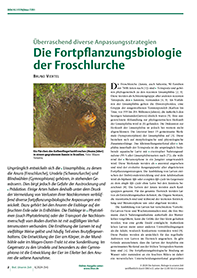The biology of reproduction in amphibia
DOI:
https://doi.org/10.11576/biuz-7251Keywords:
Lissamphibia, Froschlurche, Fortpflanzungsbiologie, AnpassungenAbstract
Originally, amphibia reproduced in waters. They evolved astonishing adaptations to escape from desiccation and predation. The new adaptations of Anurans include small water-bearing phytotelmata, epiphytes, tree hollows or terrestrial alternative biotopes. Several species develop cryptic larvae (in the past called “directly developing larvae”), endotrophic feeding on comparatively yolk-rich eggs, parental care (transport of eggs and larvae, guarding the offspring and extra feeding with nourishing eggs) – in only a few species, the development inside the oral cavity or the stomach and very seldom the development within the oviduct. Contrary to this, oviductal gestation occurs in Urodela more frequently and in Gymnophiona regularly.


